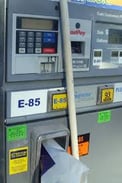How to Estimate Your Engine’s Required Fuel Flow
We are occasionally asked, what fuel flow do I need to support my application? Or, will your fuel filter flow enough for my engine? These are important questions when selecting fuel filters, lines, and pumps for a performance engine. You want to be sure that your components can deliverer the fuel needed to supply your thirsty engine.
Fuel makes power. Different types of fuel make different amounts of power. By knowing the amount of power your engine makes or is expected to make and the type of fuel you will be running you can calculate your engine’s required fuel consumption and flow.
Brake-Specific Fuel Consumption
To start the calculations for fuel consumption we use the BSFC (Brake-Specific Fuel Consumption) for the fuel being used. BSFC measures the amount of fuel needed per horsepower per hour. Fuel is measured in pounds instead of gallons.

Listed below are the BSFC ranges for average efficiency Gas, E85 & Methanol engines at their peak hp output. An engine’s BSFC can vary depending on load and RPM, these rates aim to represent the peak horsepower environment. The unit of measure here is lbs / hp / hr.
Gasoline .45 – .50
E85 .63 – .70
Methanol .90 – 1.0
You can used these BSFC values to calculate the fuel requirements for various horsepower levels. The above BSFC number tell us that our gasoline engine requires .50 lb of fuel per horsepower per hour. Said another way, we know for each horsepower our gas engine creates we will need .50 lbs of fuel per hour. Expressed as a formula it looks like this:
Given Horsepower x .50 lb fuel/hp = lbs of fuel for given horsepower
To calculate Fuel Consumption for a 400 hp Gas engine with a BSFC of .50 lbs/hp/hr:
400 hp x .50 = 200 lbs/hr
To convert this lbs/hr to a more meaningful gallons per hour we use the conversion rate from lbs to gallons which is 6.2 lbs to 1 gallon of gas
200 lbs/hr / 6.2 lbs/gal = 32.25 gph
And that’s it! Now you have an approximate peak gph fuel requirement for your engine that can guide you in choosing your fuel system components.
If you will be doing this calculation often, you can make it even easier by converting the BSFC you prefer for your fuel from the normal lbs/hp/hr unit of measure to a gal/hp/hr measure. This way you will only need to multiply your horsepower by that figure to arrive at your GPH rate, without the need for converting from lbs to gallons after.
BSFC .50 / 6.2 = .0806 gallons / horsepower / hour.
Again we calculate Fuel Consumption for a 400 hp Gas engine.
400 hp x .0806 = 32.24 gph
Remember, if you are running E85 or Methanol be sure to use those BSFC values in your formula. To calculate peak fuel consumption for a 800 hp E-85 engine we can use a BSFC of .70 and the formulas below.
800 hp x .70 = 560 lbs/hr 560 lbs/hr / 6.2 lbs/gal = 90.32 gph
OR
BSFC .70 / 6.2 = .113 gallons / horsepower / hour
800 * .113 = 90.40 gph
Note: These gph flow rates may seem high when compared to your daily driver on the highway, but remember these are not averages, these are flow at loaded peak output. Regarding the small differences in the numbers between the methods, that is a result in rounding differences.
What does that GPH rate mean for my Filter?

If you are using a quality fuel filter like our CM filters your filter should be out flowing the fittings and fuel lines on your car by a considerable margin. Our filter tests showed that in stock based applications with OE fittings and fuel lines in the 3/8 range the fitting and line size was the determining factor for flow.
Using our 25-902 fuel filter as an example lets see how the filter fitting size and line size relates to flow. This filter features OEM style Ford fuel fittings specifically found on the 4.6 modular motor Mustangs. In our testing this filter in isolation flows close to 100 GPH with around 1/2 psi resistance. It can do this because the filtration media is designed for high flow and the point of restriction is limited to the stock style fittings in and out which are short in distance. Compare that to the long length of stock 3/8 fuel line running to and from the filter. The long length and twist and turns in the fuel line mean resistance to flow is much greater. In this application the stock line would not be able to flow much more then 60 GPH without significant pressure flow restriction accumulating.
When planning your fuel delivery system we recommend first starting with an estimate of the fuel consumption your engine will require. Then determine the line size and pump to support that flow. Next choose a quality fuel filter to match your line size that uses high flow high filtration media like our CM filters.
BSFC is a great tool to quickly examine the relationship between fuel flow and horsepower. Even though the fuel consumption required at your engine’s peak horsepower will be effected by several variables such as throttle position, RPM, and aspiration type these calculations can get you close.

